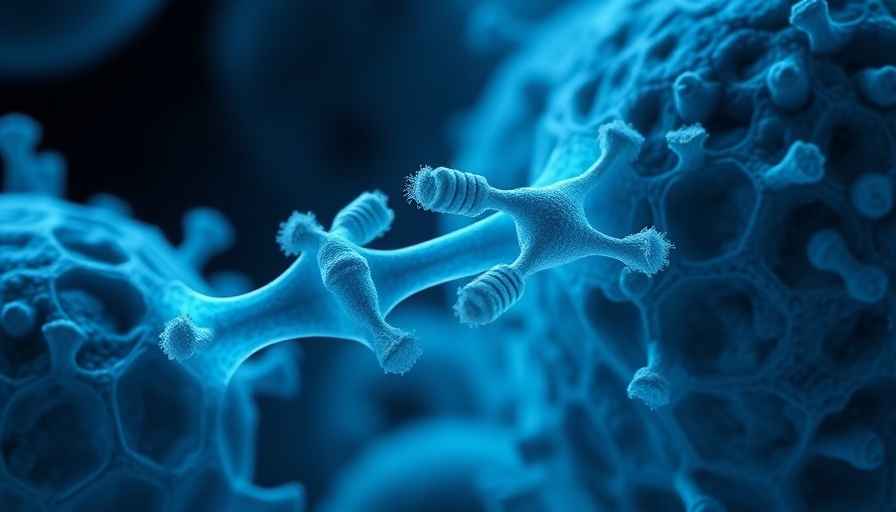
Unlocking the Secrets of Biparatopic Antibodies: A Leap Toward Cutting-Edge Cancer Treatments

2 Views
0 Comments

Unlocking Immune Health: The Role of Serine Proteases in Longevity
Update Understanding Neutrophils: Your Body's First Line of Defense Imagine your body's immune system as a well-trained army, with neutrophils playing the role of the frontline soldiers. These tiny warriors are not just any cells; they are crucial players in our immune defense, tasked with battling pathogens that could lead to illness. With granules packed with powerful antimicrobial proteins, neutrophils are armed with an arsenal, including neutrophil serine proteases (NSPs), which are vital to this operation. What Are Neutrophil Serine Proteases? So, what exactly are these neutrophil serine proteases? Think of them as specialized tools that neutrophils use to break down harmful invaders and regulate inflammation. Some of the well-known NSPs include neutrophil elastase (NE), proteinase 3 (PR3), cathepsin G (CatG), and neutrophil serine protease 4 (NSP4). Each of these proteases has its own unique mission, focusing on different aspects of immune response. NETosis: The Double-Edged Sword of Immune Defense When neutrophils encounter danger, they can enter a dramatic process known as NETosis. This is their version of a heroic last stand, where they release neutrophil extracellular traps (NETs). These traps are a concoction of decondensed chromatin and intracellular proteins designed to catch and neutralize invaders. Surprisingly, not all cells die during NETosis—a fact that’s surprising to many and reflects the complexity of our immune responses. The Role of Metabolism in NET Formation You might be wondering how energy comes into play here. Just like athletes need fuel, neutrophils require metabolic pathways to form their NETs effectively. Research shows that essential nutrients like glucose and glutamine enhance NET formation. Under glucose-free conditions, neutrophils struggle to perform NETosis, even when stimulated. Insights from Recent Research Trends A curious trend observed in recent research is the increasing focus on the role of NSPs during NET formation. As scientists peel back the layers of complexity, the mechanisms of NET release, involving ROS and other factors like NADPH, come to light. This has prompted many to delve deeper into NSP activity regulation during processes such as degranulation associated with NET release. Dangers of Dysregulated NETosis However, like any powerful defense mechanism, there’s a risky side. Dysregulation of NETosis and NSP activity can lead to pathological conditions and diseases. Understanding the delicate balance of NSPs and their contributions in both health and disease offers critical insights into potential therapeutic avenues. The Future of Health and Immune Research While discussions about neutrophils and their roles have traditionally been confined to scientific circles, they hold immense relevance for anyone interested in longevity, cellular health, and overall well-being. With each new discovery, we inch closer to unraveling how these processes can inform strategies not just for disease prevention but for health optimization. Practical Health Tips Considering Neutrophil Function So, what does all this mean for your health? While we might not all become immunologists, a few wellness strategies may help optimize our body's defense mechanisms. Consider focusing on nutrient-rich diets to support metabolic pathways, engaging in regular exercise, and prioritizing good sleep to enhance your overall healthspan. As we learn from these intricate biological processes, it's essential to incorporate science-backed health insights into our daily lives. Who knew that understanding neutrophils could play a part in your quest for longevity? By taking proactive steps in nutrition and lifestyle choices, we can better support our body's intricate defense mechanisms. In summary, the exploration of neutrophil serine proteases and NETs offers a window into the dynamic world of our immune system, opening new avenues in health and wellness. The promising research points to exciting opportunities for advancing our understanding of disease prevention and health optimization strategies. Stay tuned for more updates as scientists uncover new findings in this thrilling field!

Exploring Neuronal Guidance Signaling and Its Impact on Cellular Rejuvenation
Update Understanding Neuronal Guidance Signaling Neuronal guidance signaling plays a pivotal role in the intricate processes of neural development and maintenance. This signaling ensures that neurons establish precise connections, a cornerstone in the formation of functional neural networks. The significance of neuronal guidance genes cannot be understated as they produce proteins acting as cues, analogs, and intracellular signaling effectors that dictate the wiring of neurons and the sustenance of synapses throughout life. Implications of Disrupted Signaling The disruption of neuronal guidance pathways correlates with various neurological conditions, including developmental and neurodegenerative disorders. Emerging research has isolated mutations and dysregulations in these signaling mechanisms as key players in conditions ranging from autism spectrum disorder to epilepsy. This highlights the pressing need for a deeper understanding of neuronal guidance as a foundation for potential therapeutic approaches. Draxin: A Key Player in Neural Development Draxin, an axon guidance protein, is a significant component in the development of crucial neural pathways, especially in the forebrain. Studies reveal that draxin knockout mice exhibit substantial structural abnormalities in critical regions such as the corpus callosum and hippocampal commissures. The genetic implications of draxin deletion notably highlight its contextual relationship with ASD, reinforcing the concept that early neural development is inherently linked to long-term neuropsychiatric health. The Role of Arx in Neurodevelopmental Disorders The Aristaless-related homeobox (Arx) gene offers a compelling case for transcriptional regulation within the framework of neuronal development. Mutations in Arx have been implicated in various neurodevelopmental disorders, raising questions surrounding the migration and differentiation of interneurons. Recent investigations utilizing conditional knockout methods verify Arx's crucial role in progenitor differentiation, signaling it as a potential target for regenerative approaches in brain health. Applications in Regenerative Medicine The intersection of neuroscience and regenerative medicine presents intriguing possibilities. Understanding neuronal signaling pathways can inform strategies for cellular rejuvenation, particularly as it pertains to therapies involving stem cells and gene editing. By illuminating pathways that promote cellular health, such as enhancing mitochondrial function and optimizing autophagic processes, researchers can progress toward reversing cellular aging and mitigating neurodegenerative decline. Future of Cellular Health and Aging As research advances, the potential for actionable therapies targeting neuronal guidance signaling will become increasingly relevant. The integration of knowledge from both developmental biology and regenerative practices can lead to unparalleled breakthroughs in anti-aging therapies, emphasizing the importance of maintaining cellular vitality through informed interventions. For individuals eager to stay informed about the latest advancements in cellular rejuvenation and potential therapies, engaging in this discourse not only enhances personal knowledge but also encourages the exploration of how these insights can translate into practical applications in health and wellness. It’s essential to recognize that understanding the biological basis of neuronal health influences the broader landscape of preventive and therapeutic strategies.

Unlocking Longevity: How K2P2.1 Potassium Channels Influence Brain Health
Update Unveiling the Role of K2P2.1 Potassium Channels in Brain Health As health-conscious individuals, we often focus on diet and exercise to maintain our well-being. However, the microscopic world within our bodies is equally fascinating and influential in shaping our health. A recent study sheds light on a potassium channel known as K2P2.1, which plays a critical role in brain endothelial cells and has significant implications for longevity and cellular health. The Blood-Brain Barrier: A Vital Player in Healthspan Optimization The blood-brain barrier (BBB) serves as a gatekeeper for our central nervous system, selectively allowing essential substances while blocking harmful entities. The K2P2.1 channel is found on the endothelial cells forming this barrier, indicating its importance in maintaining our brain health. When the BBB is compromised, as seen in various neurological disorders, immune cells can infiltrate the CNS, leading to degenerative conditions, like multiple sclerosis. How K2P2.1 Channels Affect Endothelial Cell Functionality Researchers found that when K2P2.1 is absent (in Kcnk2−/− mice), brain microvascular endothelial cells exhibit altered structures with excess membrane protrusions. These changes facilitate the adhesion and migration of immune cells, suggesting that K2P2.1 plays a critical role in regulating immune responses at the BBB. In short, this channel acts as a conductor in the orchestra of immune cell communications, ensuring that the BBB performs its role flawlessly. Implications for Longevity and Disease Prevention Understanding the mechanisms behind K2P2.1 provides valuable insights into disease prevention and longevity. Enhancing the function of potassium channels could be a new approach to supporting the integrity of the BBB. By maintaining a healthy blood-brain barrier, we may not only reduce the risk of neurological disorders but also optimize our overall healthspan, allowing us to age gracefully. Research Insights: The Actin Network Connection The interesting twist lies in the connection between K2P2.1 and the actin cytoskeleton. As K2P2.1 levels diminish, proteins that modulate actin dynamics, like cofilin, become activated. This suggests that the potassium channel directly influences how our cells communicate and respond to their environment, paving the way for future treatments aimed at downregulating detrimental immune responses while enhancing healing processes. The Future of Biohacking: Targeting Potassium Channels What does this mean for our wellness strategies? It reveals potential biohacking avenues—by developing supplements or therapies targeting potassium channels like K2P2.1, we could not only counteract inflammation but perhaps also enhance cellular health. Imagine a holistic approach to longevity, where informed biohacking techniques would empower you to optimize your brain and body. Your Action Plan for Enhanced Healthspan So, what actionable steps can we take based on these findings? **Diet and supplements** that support potassium channel function might be a good start. Consider investing in a well-rounded nutrition plan rich in potassium-containing foods, such as bananas, avocados, and spinach. Also, look out for emerging health products that focus on cellular dynamics and actin regulation as part of your holistic wellness strategy.
 Add Row
Add Row  Add
Add 

Write A Comment